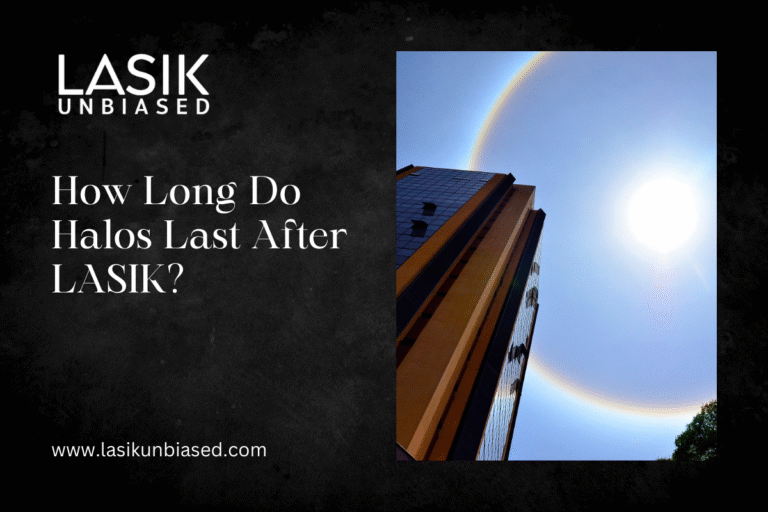Halos after LASIK surgery are generally temporary, often diminishing significantly within the first few weeks. For most patients, they resolve entirely within three to six months.
LASIK (Laser-Assisted In Situ Keratomileusis) is a life-changing vision correction procedure that has helped countless individuals reduce their dependence on glasses or contact lenses. However, as with any surgery, there are side effects, and one of the most commonly reported is seeing halos around lights during recovery. Understanding why halos occur, how long they last, and ways to manage them can help set expectations and provide reassurance about this common healing process.
Why Do Halos Occur After LASIK?
Halos are visual phenomena where lights appear to have a glowing, circular haze around them. This effect typically becomes apparent in low-light conditions or during the night. Here’s why halos can appear:
Changes in Corneal Shape
LASIK surgery involves reshaping the cornea to correct refractive vision errors such as myopia, hyperopia, or astigmatism. This reshaping can lead to temporary changes in how light is refracted by the cornea, and during the healing phase, minor irregularities may cause light to scatter, producing halos.
Impact of Pupil Size
During hours of low illumination, pupils dilate to allow more light into the eyes. If the pupil dilates beyond the optical zone (the area treated by LASIK), unfocused peripheral light may enter the eye, increasing the risk of halos or glare, particularly at night.
Healing and Swelling
Post-surgical healing can lead to swelling or minor irregularities in the corneal surface. Such temporary swelling or surface irregularities can induce mild refractive distortions, contributing to the appearance of halos.
Tear Film Instability
LASIK can temporarily disrupt normal tear production, resulting in dry eye symptoms. A disrupted tear film can also scatter light unevenly, intensifying the perception of halos.
Remember, halos are often a transient side effect of LASIK and do not indicate a permanent issue in most cases.
How Long Do Halos Last After LASIK?
The duration of halos varies between individuals, as it depends on factors such as the healing rate, the severity of the initial refractive error, and lifestyle. Below is a general timeline of recovery and how halos evolve:
Immediate Post-Surgery Period
- First Few Days
Right after LASIK, halos are often more pronounced due to temporary corneal edema and surface irregularities caused by the healing process. This is when most patients notice heightened sensitivity to light, accompanied by halos or glare.
- One Week After Surgery
Within the first week, swelling usually begins to subside, and the frequency or intensity of halos may decline slightly. However, it is imperative to adhere to the post-operative care instructions provided by your physician.
One to Three Months
- Gradual Improvement
Halos typically become less noticeable as epithelial remodelling occurs and the visual system adapts to the changes in corneal shape. Most patients find that by the three-month mark, halos are either significantly reduced or have disappeared entirely.
Beyond Three Months
- Resolution for Most Patients
Most individuals experience a noticeable reduction in halos within three to six months after surgery. However, in some cases, symptoms may persist beyond this period. Factors such as significant refractive corrections, persistent dry eye, or larger pupil sizes can contribute to prolonged symptoms.
- Persistent Cases
For a small percentage of LASIK patients, halos may persist longer. Persistent halos can often be managed through medical interventions such as refractive enhancements, advanced lubricating therapies, or treatment for underlying conditions like dry eye disease.
Factors That Influence Halo Duration
Certain personal and surgical factors can impact the duration and intensity of halos after LASIK. Some of these variables include:
Severity of Prescription Before Surgery
Individuals with high degrees of myopia or astigmatism may be more prone to experiencing halos due to the greater extent of corneal reshaping required. These patients might also take longer to fully adapt visually.
Natural Pupil Size
Larger pupils tend to increase the likelihood of halos, especially in dim environments where the pupils dilate significantly.
Healing Rate and Age
Younger individuals tend to heal more quickly, while older individuals may experience slightly prolonged recovery times. The rate of corneal healing also varies from person to person.
Technique and Surgeon Skill
Advancements in LASIK technology—such as wavefront-guided and topography-guided procedures (e.g., Contoura Vision)—have significantly reduced the risk of halos by enabling more customised and precise corneal reshaping. Choosing a highly experienced refractive surgeon is crucial, as surgical technique plays a significant role in reducing visual aberrations like halos.
Managing and Reducing Halos During Recovery
Although halos are a natural part of LASIK recovery, there are steps you can take to manage and mitigate their impact during the adjustment period:
Follow the Recommended Eye Care Regimen
- Utilise prescribed eye drops to alleviate dryness and support the healing process. They help maintain a stable tear film and minimise light scattering.
- Avoid rubbing or touching your eyes to prevent disruption of the healing corneal surface.
Limit Bright and Harsh Lighting
- Consider using anti-reflective lenses or screen filters to minimise glare and visual strain from digital devices during the recovery period.
- Limit nighttime driving if halos or glare interfere with your visual clarity during recovery.
Stay Patient
Healing takes time. Halos often resolve on their own, so patience and adherence to follow-up care are crucial.
When to Seek Medical Advice?
While halos usually diminish over time, there are instances where they warrant professional evaluation. Contact your eye doctor if you:
- Continue to experience halos beyond six months post-surgery.
- Notice a sudden increase in intensity or the appearance of additional symptoms, such as eye pain or blurry vision.
- Feel that halos are severely impairing your quality of life, particularly in low-light conditions.
Your eye doctor may recommend treatments such as custom LASIK enhancements, managing dry eye syndrome, or corneal surface optimisation to address persistent halos or visual disturbances.
Advanced Technologies That Address Halos
Improved LASIK techniques have drastically reduced the occurrence of post-surgery halos. Some cutting-edge options include:
- Wavefront Technology
This technique uses detailed wavefront maps of the eye’s optical system to correct higher-order aberrations, offering more precise vision correction and potentially reducing the risk of visual disturbances like halos.
- Topography-Guided Lasers
This method customises treatment based on detailed maps of the corneal surface, allowing for improved smoothness and alignment, which can help reduce light scatter and halos.
- Customised Surgical Planning
Custom LASIK approaches that consider pupil size, corneal shape, and individual visual needs can enhance treatment accuracy and minimise side effects such as halos or glare.
What You Can Do to Minimise Halos Before Surgery?
If you’re considering LASIK but are concerned about halos, here are a few precautions to take:
- Discuss Risks with Your Surgeon: Provide detailed information about your medical history, lifestyle, and expectations.
- Undergo a Thorough Evaluation: Ensure your eyes are healthy and suitable vision correction methods are recommended for you.
- Choose Advanced Techniques: Opt for newer LASIK technologies, even if they come at a higher upfront cost. Minimised risks and better healing are worth the investment.
Takeaway for LASIK Patients
Halos after LASIK are a manageable and temporary side effect for most patients. They usually fade within a few weeks to months, leaving you with improved vision and newfound freedom from corrective lenses. By staying informed and following your doctor’s instructions, you can enjoy a smooth recovery experience.
If you have concerns about halos or would like expert advice tailored to your unique needs, schedule a consultation with your LASIK professional. Clarity and confidence in your decision-making can be as clear as your vision post-surgery!


